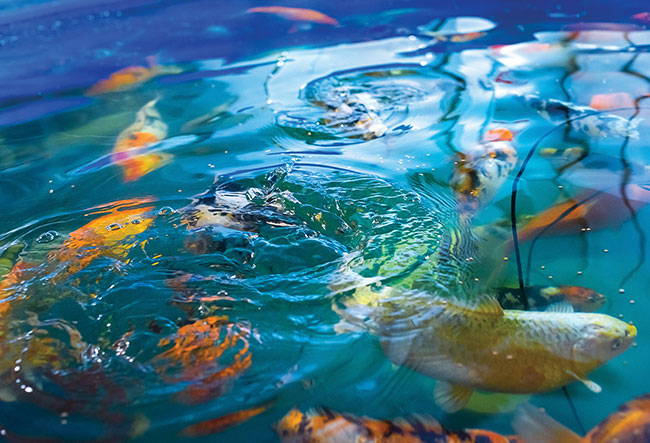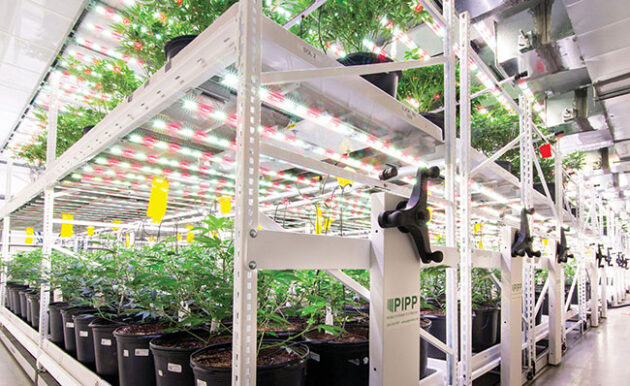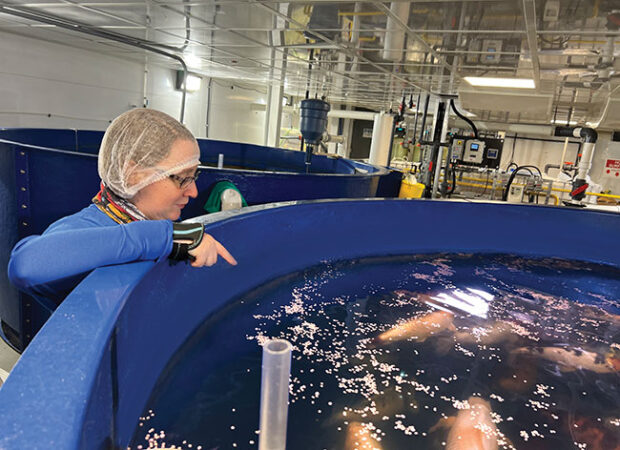
Features
Business
Cultivation
Production
Cannabis and aquaculture: a perfect match?
East Coast LPs Aqualitas and Stewart Farms share why they paired cannabis production with fish farming
May 19, 2023 By Matt Jones
 Brooklyn, N.S. LP Aqualitas farms koi fish in their decoupled aquaponics system.
Photo: Aqualitas
Brooklyn, N.S. LP Aqualitas farms koi fish in their decoupled aquaponics system.
Photo: Aqualitas As in the famous pairings of chocolate and peanut butter or Cheech and Chong, some things just go well together. That appears to be the case with cannabis production and aquaculture.
Several Canadian LPs have paired their cannabis production with fish farming efforts, with significant benefits to the product and the bottom line. While aquaculture can be an incredibly difficult business in which to make a living, these producers say that farming fish, not as a primary product but as a support to their cannabis production, has been very effective.
Definition: For readers who may not be familiar, aquaculture is the general catch-all name for all types of aquatic farming. Aquaponics is a type of aquaculture where fish and crops are grown in a mutually beneficial way. As opposed to the similar hydroponics – where the optimal conditions for a crop are simulated – an aquaponics system will typically attempt to create an ecosystem where the fish can feed off the crops that are grown and the crops are nourished by the fish waste.
When the crops, fish, and assorted bacteria are in perfect balance with each other, these systems can be self-sustaining, even cleaning their own water. Cannabis producers have typically been using what is called a ‘decoupled’ aquaponics system, where the fish and crops are kept separately, but the fish waste is collected and used as a fertilizer, either on their own or in tandem with other nutrient inputs.
AQUALITAS ’ KOI FISH
Based out of a facility in Brooklyn, Nova Scotia, Aqualitas was founded by Myrna Gillis, a disability lawyer who saw the benefits of medical cannabis for her clients.
Aqualitas director of science and cultivation technology Danielle Maitland says that while looking at different methods of growing, she came across aquaponics, which had a reputation for being environmentally sustainable.
“[Gillis] spoke with several experts,” says Maitland, “and was told ‘it grows the best cannabis we’ve ever seen, but it’s really hard to do.’ But that wasn’t a deterrent. Aquaponics has traditionally been used for leafy greens, like lettuce and spinach, that have a very simple lifecycle. They’re only growing leaves, whereas cannabis is a flowering plant and has a bit more complex lifecycle and has different nutrient requirements over the course of that lifecycle, which does make it difficult to do aquaponically.”
The company had little experience with the cultivation method, so they conducted a variety of research trials to figure out the technique. In the end, the cannabis that was produced through aquaponics received better feedback from customers than cannabis produced through other means. But they don’t know exactly why.
“We have theories,” says Maitland. “We don’t know the exact mechanism of why it translates to such good product, and we are looking at some research projects to try and figure that out. But our working theory is twofold: one, the nutrients that come from the aquaponics system are very available to the plants – they’re in an ionic form dissolved in the water, so the plant can really easily uptake them.

A cleanly, LED lit two-tier vegetation room at Aqualitas.
Photo: Aqualitas
“And the second part is that the system is very microbially active. The water that we use is filled with beneficial microbials. The soil that we use is filled with beneficial microbials. And when the plant has a really healthy microbiome at the roots, it’s also better able to uptake nutrients, anything that isn’t immediately in an available form will be broken down into an available form by those microbes in that soil food web around the plant roots.”
There have also been some theories that THC and terpenes are an immune response with the plant, so microbial life at the roots would tell the plants that they should protect themselves in case some of them are bad. All of that is theoretical currently, but it lines up with Maitland’s observations.
“And in terms of the bumps that we see in yield and bud size, I believe that would be a combination of the very available nutrients and the microbes being present to solubilize any nutrients that aren’t immediately available so the plant can pick them up,” says Maitland.
The biggest challenge, Maitland says, is that both cannabis and aquaponics are fairly new commercial scale products. There isn’t a huge amount of research and trade knowledge that the company can rely on and thus are largely left to blaze their own trail.
Even more so with the fish which they produce in their system – koi, a fish which is seldom raised in recirculating aquaculture systems. Maitland muses that she’s asked, ‘why koi?’ almost every time she gives a presentation on behalf of the company.
“Koi do very well at the water temperature we want to use for irrigating the cannabis,” says Maitland. “They also have very wide environmental tolerances. We live in Canada, and the incoming water can go from four degree Celsius up to 25, and koi can live anywhere in that range. So, if our water heating or cooling equipment broke down, the koi would always be fine. They’re very tolerant to the high nutrient density in the water. They’re fine at lower pH and can handle lower oxygen than some other species.”
The company raises the koi in a 60,000-liter system with seven grow tanks. As of right now, they sell a few koi here and there, but it’s not a significant source of income for the business. Mostly, the koi are there to support the cannabis, not as a product in their own right. However, that may change in the future. With their current knowledge of the systems, Aqualitas could be producing 3000 baby koi every three months if they so desired.

Danielle Maitland, director of science and cultivation technology, Aqualitas, takes a gander at the koi they raise alongside their cannabis in an aquaponics system.
Photo: Aqualitas
STEWART FARMS ’ TILAPIA
New Brunswick-based Stewart Farms, on the other hand, was grown out of an aquaponics background. Founder Tanner Stewart started out aquaponically farming leafy greens and herbs in Alberta almost a decade ago. Stewart says that he became enamoured with aquaponics as soon as he was introduced to the concept while working at a tech startup.
“It just made complete sense to me,” says Stewart. “It’s ecosystem-based farming, or another way to look at it is waste stream recovery farming, where you’re taking a protein source – farmed fish – and you’re capturing what would normally just be a waste stream, that is extremely high-quality manure, which is nutrient rich, microbial rich fish effluent, and you’re taking that waste stream and using it to grow higher quality plants. From that moment forward, I said that’s what I’m interested in.”
Stewart Farms is a largely research-focused company, and most of their current research is looking at the microbiome living in their soil and analyzing it, and the microbial cultures and comparing them to the microbial cultures and the microbiome in their fish water, as well as the intermingling of the soil and the water.
The tilapia raised in Stewart Farms’ system will be donated to culinary courses, local restaurants or in some cases will simply be eaten by staff. Once the company hosted a dinner party in Toronto and had a top chef cook their tilapia as one of the courses, as well as incorporating some of their cannabis flower into the dishes.
It was hoped by some proponents of aquaponics that the technique would revolutionize the aquaculture sector due to its sustainability benefits. But, while there are companies that have done well with aquaponics, that has not happened as of yet, most likely due to how much capital it requires to develop a fully functioning system and business. In Stewart’s experience, it is much easier to run an aquaponics system in support of your cash crop, rather than trying to make the fish and crop equal parts of the business.
“It’s two completely different businesses,” says Stewart, of trying to monetize both the fish and the crops in an aquaponics system. “They have completely different distribution mechanisms, different price bases and different cost bases, and they each have their own breakeven point. It needs to be approached from a standpoint of running two very different businesses.”
Stewart says that his first system in Alberta was a closed loop – with water cycling back and forth between the plants and the fish at all times. But there were sacrifices that had to be made on both sides. In his experience, it is much easier and more effective to grow fish and plants separately.
“So, the biggest lesson I took from that is don’t do that,” says Stewart, with a laugh.
“Build your fish farm and pull the water out of your fish farm into a secondary holding tank and get that water to where you need it to be the fish effluent. We run a decoupled system now, so then you optimize your fish farm, and you optimize your plant production.
“So my version of aquaponics is a fish farm beside a plant farm. You just need to be able to access the fish effluent and take it over to the plant farm. You don’t want to have to sacrifice two things at once; you want them to be able to be optimized beside each other.”
All of the decisions about how those systems are designed are crucial and interconnected Stewart advises. Whether you’re raising a warm or cold-water fish, for example, will determine whether you need to heat or cool the water before it is used on the plants.
Cannabis plants like water about 22 degrees, he says, so Stewart Farms chose tilapia over salmon, as the ideal temperature for tilapia is a little closer to that. The nutritional value of the effluent will also vary from species-to-species due diet variations as well. As such, and with all types of farming, the most important thing is to understand the techniques you are employing, the crops you are growing, and how all the parts of the system will work together.
“Today, Stewart Farms’ goal is to drive research and innovation on the microbiome,” says Stewart. “That’s the purpose of our fish farm today. Does Stewart Farms plan or have the intention at least, to potentially build a larger scale, fully profitable fish farm? The answer is yes. Will we do that with tilapia? I’m uncertain at this point because we’re not focused on that right now. I’m focused on research and plant growth and promoting bacteria and microbes.”
Matt Jones is a freelance writer and journalist who specializes in trade publications. He lives with a cat named Bowie in Frederiction, New Brunswick.
Print this page